Tire Size 225/55r17 vs 225/60r17
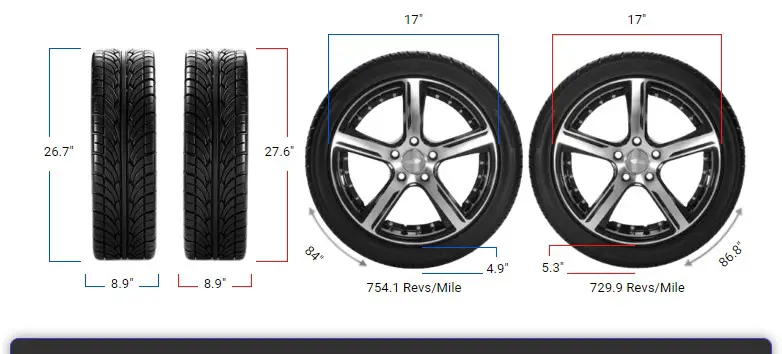
Switching from 225/55R17 to 225/60R17 tires involves a slight increase in overall diameter and sidewall height. This change affects various aspects of vehicle performance, including ground clearance, speedometer accuracy, and ride comfort.
- Tire diameter increases by 3.3%, just exceeding the recommended 3% limit
- Sidewall height grows by 9.1%, improving ride comfort and off-road capability
- Speedometer accuracy decreases slightly, showing lower speeds than actual
- Ground clearance increases marginally, benefiting off-road performance
- Minimal impact on fuel efficiency and handling characteristics
The primary distinction between 225/55R17 and 225/60R17 tires lies in their overall diameter and sidewall height. The 225/60R17 tire is 0.89 inches (22.5 mm) larger in diameter, representing a 3.3% increase.
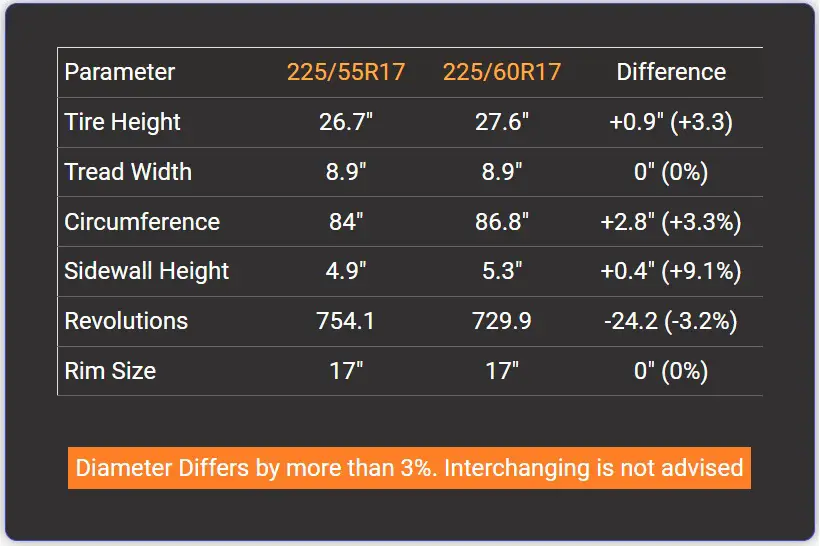
Fitment Guide
It’s crucial to stay within the manufacturer’s recommended size range. The 3.3% diameter increase from 225/55R17 to 225/60R17 slightly exceeds the typical 3% guideline.
While this small overage may be acceptable for some vehicles, it’s essential to consult your vehicle’s manual or a tire professional before making the switch.
On-Road Impact
Changing tire sizes can affect your vehicle’s on-road performance in several ways. Here’s how the switch from 225/55R17 to 225/60R17 might impact your daily driving experience:
- Ride Comfort: The taller sidewall of the 225/60R17 tire (5.31 inches vs. 4.87 inches) provides more cushioning, potentially resulting in a smoother ride over bumps and rough roads. This increased comfort can be especially noticeable on long drives or when traversing poorly maintained roads.
- Speedometer Accuracy: Due to the larger overall diameter, your vehicle’s speedometer will slightly underreport your actual speed. For example, when your speedometer reads 20 mph, you’ll actually be traveling at 20.66 mph. While this difference may seem minor, it’s important to be aware of it, especially when driving in speed-sensitive areas or during long trips.
- Handling: The taller sidewall might introduce a slight decrease in cornering responsiveness. This change is often negligible for everyday driving but could be noticeable during more spirited cornering or emergency maneuvers.
- Fuel Efficiency: The larger diameter tire will have a minimal impact on fuel efficiency. The difference in revolutions per mile (754.11 vs. 729.94) is small enough that most drivers won’t notice a significant change in their gas mileage.
- Aesthetics: The taller tire may give your vehicle a slightly more aggressive or lifted appearance. This change can be visually pleasing to some drivers, particularly those with SUVs or crossovers.
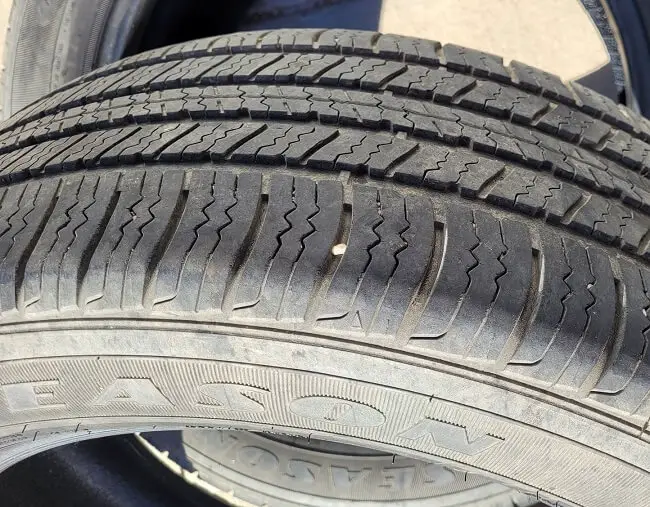
Off-Road Impact
For those who occasionally venture off the beaten path, the switch to 225/60R17 tires can bring some benefits:
- Ground Clearance: The 0.89-inch increase in overall diameter translates to about 0.45 inches of additional ground clearance. While this may seem minimal, it can make a difference when navigating rough terrain or obstacles.
- Traction: The taller sidewall allows for better tire deformation over uneven surfaces, potentially improving traction in loose or rocky conditions. This can be particularly beneficial for light off-road use or during inclement weather.
- Durability: The increased sidewall height may offer slightly better protection against impacts with rocks or other off-road hazards, potentially reducing the risk of sidewall damage.
- Comfort: Just as on paved roads, the taller sidewall can provide improved comfort when driving on rough off-road trails, absorbing more of the bumps and vibrations.
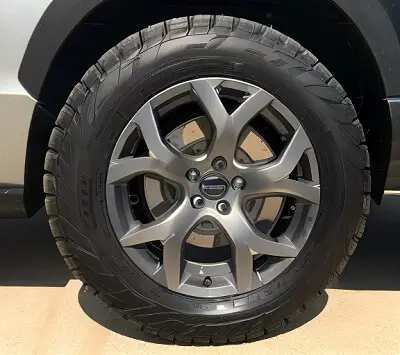
What is the Difference Between 225/55r17 and 225/60r17?
The main difference between 225/55R17 and 225/60R17 tires lies in their overall diameter and sidewall height. The 225/60R17 tire has a larger diameter of 27.63 inches compared to 26.74 inches for the 225/55R17, resulting in a 3.3% increase.
This difference primarily stems from the taller sidewall of the 225/60R17, which measures 5.31 inches versus 4.87 inches for the 225/55R17. This change in dimensions affects various aspects of vehicle performance, including ride comfort, ground clearance, and speedometer accuracy.
Can I Use 225/55r17 Instead of 225/60r17?
The 3.3% difference in diameter slightly exceeds the typical 3% guideline for tire size changes. This means that using a 225/55R17 instead of a 225/60R17 could potentially affect your vehicle’s performance, speedometer accuracy, and clearance.
It’s crucial to consult your vehicle’s manual or a tire professional before making this switch to ensure it won’t cause any issues with your specific vehicle model.
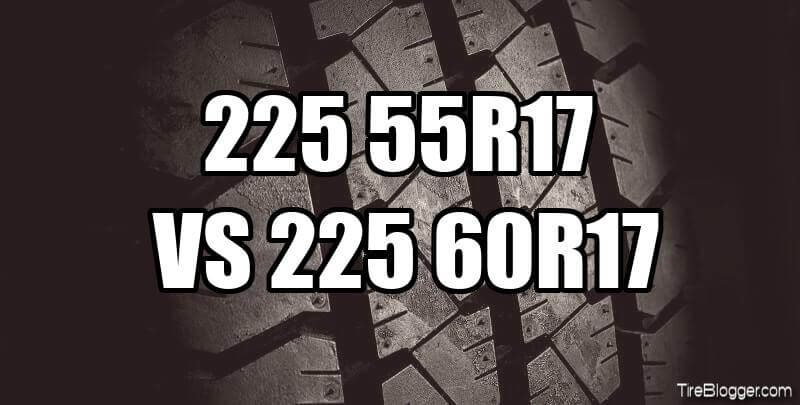
How Much Taller Is A 225/60r17 Tire Than A 225/55r17?
A 225/60R17 tire is 0.89 inches (22.5 mm) taller than a 225/55R17 tire. The overall diameter of the 225/60R17 is 27.63 inches (701.8 mm), while the 225/55R17 has a diameter of 26.74 inches (679.3 mm).
This difference represents a 3.3% increase in height, which can affect various aspects of your vehicle’s performance and appearance.
How Much Wider is a 225/60r17 Tire Than a 225/55r17?
There is no difference in width between a 225/60R17 and a 225/55R17 tire. Both tires have a width of 8.86 inches (225 mm).
The numbers “225” in both tire sizes represent the tire’s width in millimeters, which remains constant. The difference between these two tire sizes is in their aspect ratio (55 vs. 60), which affects the sidewall height but not the width.
Our Observation
Switching from 225/55R17 to 225/60R17 tires offers a mix of benefits and minor drawbacks. The increased sidewall height improves ride comfort and provides a slight boost in ground clearance, which can be advantageous for both on and off-road driving.
However, the change slightly exceeds the recommended 3% diameter difference, which may affect speedometer accuracy and could potentially cause fitment issues in some vehicles.
For most drivers, the performance differences will be subtle, with the most noticeable changes being improved ride comfort and a slightly more imposing visual appearance.
While the impacts on handling and fuel efficiency are generally negligible, it’s crucial to ensure proper fitment and be aware of the small speedometer discrepancy.

Meet Caitlin McCormack, a Tire Size Expert and Blogger Passionate About Everything Related to Tires. With Years of Experience in the Tire Industry, Caitlin Has Become an Expert in Tire Sizes and Their Impact on Vehicle Performance.
